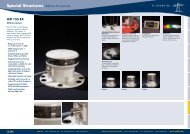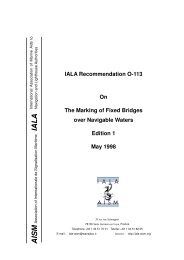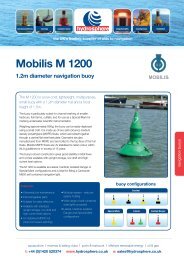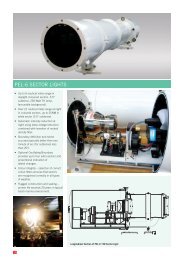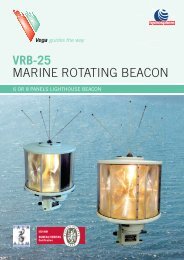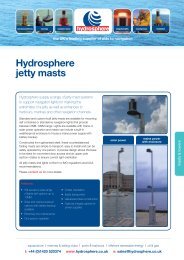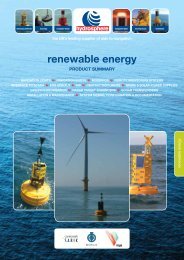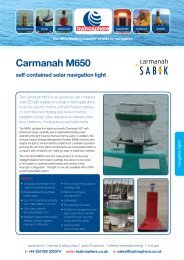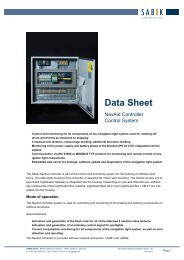Hydrosphere UK Ltd Complete Products & Services Catalogue
Hydrosphere UK Ltd Complete Products & Services Catalogue
Hydrosphere UK Ltd Complete Products & Services Catalogue
You also want an ePaper? Increase the reach of your titles
YUMPU automatically turns print PDFs into web optimized ePapers that Google loves.
ABOUT SECTOR LIGHTS<br />
PEL Sector Lights display a different<br />
colour when viewed from different angles<br />
at sea. Very sharp colour boundaries – a<br />
complete colour change typically occurs<br />
within 1 minute of arc. With optional<br />
oscillating boundary, the signal alternates<br />
between two colours in proportion to the<br />
distance across the sector. PEL Sector<br />
Lights indicate the precise vessel position<br />
in confi ned waterways. They are used<br />
in situations where extreme accuracy is<br />
required, or where only a single station is<br />
possible. Each light is custom-confi gured<br />
for its site. Range up to 6NM by day<br />
from PEL-6.<br />
Defi nition of a Sector Light<br />
A Sector Light is a single light which<br />
shows a different colour when viewed<br />
from different directions. The colour of<br />
the light provides directional information<br />
to the mariner. The letters “PEL” stand<br />
for Physics and Engineering Laboratory<br />
of the New Zealand government research<br />
facility where the fi rst PEL light was<br />
designed.<br />
Benefi ts of PEL Sector Lights include<br />
ease of location, energy effi ciency, and<br />
cost savings. PEL Lights only require a<br />
single station for direction-indicating,<br />
saving on the costs of a rear light,<br />
including site access, power supply and<br />
structures.<br />
PEL Sector Lights have been applied to<br />
a wide range of uses. Although mainly<br />
used as single-station leads, they have<br />
been used to mark anchorages, turning<br />
basins, fi shing zones, hazardous reefs,<br />
national boundaries and prohibited<br />
areas.<br />
Sector Light Vocabulary<br />
Total Subtense<br />
Total subtense is the total projected angle<br />
in the horizontal plane. The basic light<br />
beam is circular in cross-section, and is<br />
masked down to a rectangle as shown<br />
fi gure 1 & 2.<br />
Vertical Divergence<br />
Vertical divergence is the total projected<br />
angle in the vertical plane. Stated vertical<br />
divergence applies across the full width<br />
of the beam of the PEL Light. This is<br />
always less than the horizontal subtense<br />
of the light due to the way the circular<br />
beam is masked.<br />
Boundary Resolution<br />
On the boundary between a white and a<br />
coloured sector (eg red) there is a small<br />
transition angle within which the colour is<br />
neither completely white nor completely<br />
red. Boundary resolution is the smallest<br />
angle over which a complete colour<br />
change occurs.<br />
Sector Accuracy<br />
Due to manufacturing tolerances on<br />
lenses, fi lter glasses and lens-mounting<br />
systems, the actual location of a sector<br />
boundary may be displaced a small<br />
amount from the intended place.<br />
Accuracy is the maximum angle between<br />
intended and actual location.<br />
Intensity and Range<br />
Intensity is the amount of light energy<br />
emitted from a light in a given direction,<br />
and is measured in candela. Increased<br />
intensity gives increased viewing range,<br />
but typically, range also depends on<br />
atmospheric transmissivity and level of<br />
background lighting.<br />
Oscillating Boundary<br />
An optional accessory to the PEL<br />
Sector Light which generates up to four<br />
additional sectors without using additional<br />
colours (only red, white and green). Refer<br />
to Oscillating Boundary section.<br />
Facts about Colour Integrity<br />
White and red are both satisfactory<br />
colours for use in navigation beacons.<br />
If a third colour is required, care must<br />
be taken to ensure that the chosen<br />
colour and fi lter material will maintain<br />
a consistent appearance in adverse<br />
weather conditions.<br />
Yellow is not a suitable colour because<br />
it cannot be distinguished from white,<br />
especially with fi lament lamps used at<br />
low voltage.<br />
Fog can be a problem with coloured<br />
beacons, because fog scatters light of<br />
shorter wavelength (blue) more than<br />
of longer wavelength (red). When a<br />
yellow, green or blue beacon is viewed<br />
through fog, if there is a signifi cant red<br />
component in the light, then red may<br />
be the main colour that is seen. This<br />
phenomenon has caused accidents at<br />
sea. Purple-coloured beacons should<br />
also be avoided.<br />
Despite the above, green remains the<br />
most suitable third colour. There are<br />
many blue and blue-green fi lter glasses<br />
and plastics which also freely transmit<br />
some red light. Great care is required in<br />
the selection of fi lter glass for blue-green<br />
sectors to ensure that no red light is<br />
transmitted. The use of colours other than<br />
red, white and green is not recommended<br />
2



